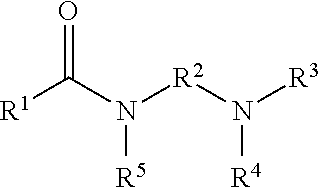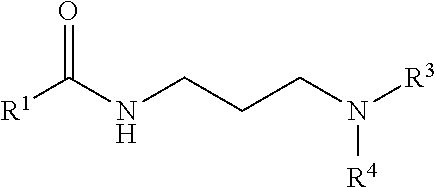Gas hydrate inhibitors
- Summary
- Abstract
- Description
- Claims
- Application Information
AI Technical Summary
Benefits of technology
Problems solved by technology
Method used
Image
Examples
example 1
Methane as Hydrate Inhibition in Oil / Water mixtures with an Anti-Agglomerate Additive
[0068]The experiments were performed using a sapphire rocking cell apparatus. Each cell has a volume of 20 mL, equipped with a stainless steel ball to aid agitation. The cells are charged with 10 mL liquid samples. The aqueous phase is either distilled (DI) water or brine (water+NaCl). The water bath is filled before the cells are pressurized with a test gas (either methane or a natural gas mix) to the desired pressure. The rocking frequency is set to 15 times / min. The bath temperature, the pressure and ball running time during rocking are recorded. After charging the cells with a test sample, they are rocked at around 20° C. for about half hour to reach equilibrium, which is set as initial condition of the closed cell test. Then the water bath is cooled from the initial temperature to 2 ° C. at different rates varying from −2° C. / hr to −10° C. / hr, while the cells are being rocked. They are then kep...
example 2
Natural as Hydrate Inhibition in Varying Water Cuts with an Anti-Agglomerate Additive
[0071]Example 2 was performed using a similar sapphire rocking cell apparatus as in Example 1. However, tests were run at constant pressure of 100 bar by continually adding gas to the cell throughout the test to replace gases removed to hydrate formation. Further, the temperature profile was set to cool from 20° C. down to 4° C. (at about 4° C. / hr for the crude oil and 8° C. / hr for the condensate), and then hold for 24 hrs, with a 16 hour rocking period, a shut-in for 6 hours, and a restart for 2 hours.
[0072]A mixture of 90 wt. % cocamidopropyl dimethylamine in 10 wt. % glycerin (AA) along with an acid scavenger (i.e., sodium or lithium hydroxide) was tested for gas hydrate inhibition in a North Sea Gas Mix (see table 4) and a stream containing from 30 to 80 wt. % water cuts (DI water or NaCl brine), and a crude oil or a condensate containing hexane, benzene, ethyl benzene, xylene and toluene). Resu...
example 3
Natural as Hydrate Inhibition in Varying Water Cuts with an Anti-Agglomerate Additive
[0073]Example 3 was performed using a similar sapphire rocking cell apparatus as in Example 1. However, a magnetic stir bar was used to aid agitation instead of a stainless steel ball. Also, tests were run either at constant pressure by continually adding gas to the cell throughout the test to replace gases removed to hydrate formation, or at constant volume as described in Example 1. Further, the temperature profile was set to cool from 20° C. down to 4° C. at about 8° C. / hr, and then hold for 24 hrs, with a 16 hour rocking period, a shut-in for 6 hours, and a restart for 2 hours.
[0074]A mixture of 90 wt. % cocamidoproply dimethylamine in 10 wt. % glycerin (AA) was tested for gas hydrate inhibition in two different hydrate forming lower hydrocarbon or other hydrate forming compound mixtures, set forth in Table 4.
TABLE 4Gulf of Mexico (GOM)North Sea (NS)Gas mixGas mixNitrogen 0.39%Nitrogen 1.75%Meth...
PUM
 Login to View More
Login to View More Abstract
Description
Claims
Application Information
 Login to View More
Login to View More - R&D
- Intellectual Property
- Life Sciences
- Materials
- Tech Scout
- Unparalleled Data Quality
- Higher Quality Content
- 60% Fewer Hallucinations
Browse by: Latest US Patents, China's latest patents, Technical Efficacy Thesaurus, Application Domain, Technology Topic, Popular Technical Reports.
© 2025 PatSnap. All rights reserved.Legal|Privacy policy|Modern Slavery Act Transparency Statement|Sitemap|About US| Contact US: help@patsnap.com



